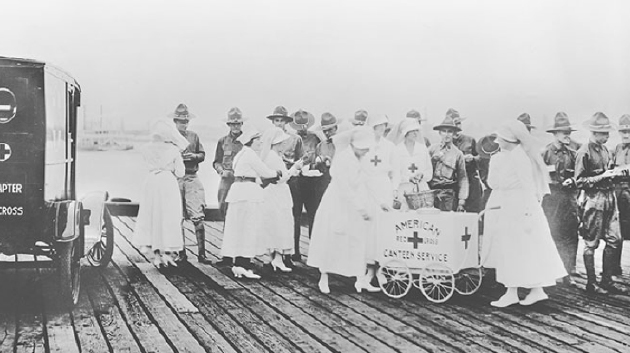The Devastation of the Second Wave of the Spanish Flu
—The Limits of Vaccine Development—
(Photo:Glasshouse Images/Aflo)
A virus commonly spreads through blood and excretions. This is why it commonly spreads to surrounding people such as families. The other type of infection which spreads through air is troublesome and typically leads to global pandemics.
During 1918 to 1920, it was this airborne novel Spanish Flu that led to a global pandemic. This instantaneously spread throughout the world, and about a half to a third of the 1.8 billion people on Earth at the time got infected, of which 50 million died.
Even at the time when international relations were sparse, the Spanish Flu spread because of the traffic of soldiers during World War I.
When the first wave hit in March 1918, the people infected recovered quickly and showed symptoms similar to that of a regular influenza. However, the situation completely turned around in September. Young soldiers in the U.S. garrison began dying of pneumonia—the virus had mutated and became deadly in autumn.
The Spanish Flu has affected Japan three times already. The first wave arrived between May and July of 1918, although the death rate was low. The second wave came around October of 1918 to May 1919, and approximately 260,000 people died.
The third wave arrived in December 1919 and lasted until May 1920, and 187,000 people are said to have died. The total death toll reached 450,000.
Humankind Should Anticipate Coexistence With the Coronavirus
We cannot neglect the possibility of the re-emergence of the coronavirus.
There is almost no doubt that the coronavirus was developed as a biological weapon by modifying the SARS virus to increase its lethality and infectivity (detailed in the June 2020 edition).
In 2015, Shi Zhengli of the Wuhan Institute of Virology in Wuhan published a paper in Nature Medicine that the coronavirus carried by bats can be spread to mice. People from the U.S. and Europe questioned the ethics of the research because primates, starting with humans, could potentially be infected. A French researcher from the Institut Pasteur in Paris previously warned that it would be impossible to trace the trajectory in the case of a virus leak.
It may take some time to close Pandora’s box.
Humankind was just able to eradicate smallpox in 1980, and the smallpox existed for at least two thousand years.
Humanity must prepare for coexistence with the virus.
We are awaiting the development of a vaccine, but coronavirus mutations have been volatile. The development will be a rat race against the rapidly-changing virus. Will humanity ever be able to escape the fear of infection before the development of a vaccine?
Interview
Vaccine Development of a Mutating Virus Is Difficult
Professor Emeritus, Colorado State University,
Anthony Tu

Profile
Born in Taipei in 1930. After graduating from the National Taiwan University under Japanese rule, Tu studied biochemistry at the University of Notre Dame, Stanford University and Yale University. Tu has expertise in poison as well as biological and scientific weapons.
The second wave has already arrived in China. Russia deported Chinese people back to China in April. There was an infected person among them, and the infection spread in the northeastern part of the Heilongjiang Province in former Manchuria. This can be referred to as an artificial second wave.
There were split opinions on whether a second wave will arrive organically. The SARS virus began in May and it organically disappeared by June. There is a theory that the disappearance was due to a weakness to heat.
By June 15, the coronavirus has infected 2.11 million people and killed 116,000 in the U.S., and it doesn’t seem as though it will disappear over the summer as did the SARS virus.
This doesn’t mean that there are no means of prevention. In general, if you catch the virus and you develop antibodies, you wouldn’t be infected the second time. This is because the antibody creates a system to attack new and invading pathogens. This is known as immunity, and vaccines take advantage of this immunity. For instance, antibodies for smallpox were created by vaccinating with cowpox beforehand.
The coronavirus is a type of influenza that consists of 30,000 RNA nucleotide bases. As time passes, one to two of these bases will mutate within a month. Like a previous influenza, this may cause previous antibodies to be ineffective. Many corporations are currently researching the development of a vaccine, but it is difficult to know if they are really effective without trying.



















